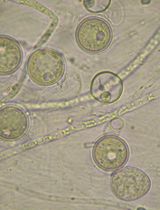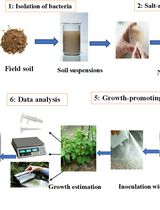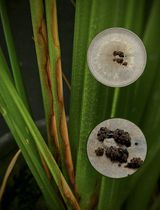- EN - English
- CN - 中文
Infection Process Observation of Magnaporthe oryzae on Barley Leaves
大麦叶片上稻瘟病菌感染过程观察
发布: 2018年05月05日第8卷第9期 DOI: 10.21769/BioProtoc.2833 浏览次数: 9657
评审: Zhibing LaiJun YangWende Liu

相关实验方案

微生物提取物对卵菌辣椒疫霉菌和猝倒病疫霉的体外筛选
Mónica Trigal Martínez [...] María Ángeles Vinuesa Navarro
2025年09月20日 1190 阅读
Abstract
Rice blast and wheat blast caused by Magnaporthe oryzae is a serious threat to rice and wheat production. Appropriate methods for observing M. oryzae infection process are important for study of the fungal infection mechanisms, plant resistance reactions, and host-M. oryzae interactions. The rice leaf sheath is commonly used to inoculate M. oryzae for observing the infection process, however, this method is a time-consuming and high technical work. Here, we describe an easier solution to observe M. oryzae infection process on barley leaves.
Keywords: Magnaporthe oryzae (稻瘟病菌)Background
The filamentous fungus Magnaporthe oryzae can cause destructive rice blast and wheat blast diseases, which can also infect barley (Kohli et al., 2011; Dean et al., 2012). M. oryzae has been studied as a model to understand fungal-plant interactions (Yan and Talbot et al., 2016). This fungus initiates its infection by attaching the conidium to host surface, then the conidium germinates and forms a dome-shaped appressorium, by which it can penetrate into host cell for colonization (Wilson and Talbot, 2009). In host cells, the fungus colonizes as a biotrophic manner by forming bulbous and branched infection hyphae to interact with host defense system (Kankanala et al., 2007). M. oryzae sequentially invade living host cells and finally transformed into necrotrophic growth, during which the lesions appear and sporulation occurs. In order to study the fungal infection mechanism, or protein functions during infection, or plant defense reaction, it is required to observe cellular infection process of different strains in host cells. A rice leaf sheath method has been commonly used to observe the infection process (Koga et al., 2004), however, this method needs to waste a long time to prepare the rice leaf sheath, and the inoculation and sample preparation need a great deal of experience. Because barley is also the host of M. oryzae, and its leaf epidermis is easy for tearing, so we found that barley leaf epidermis method is an effective and simple method to observe the infection process of M. oryzae.
Materials and Reagents
- Petri dishes (6 cm and 9 cm diameters, ASONE)
- Lens paper (Fisher Scientific)
- Filter paper (Whatman)
- Medical gauze (Angyang Medical)
- Absorbent paper (Kimberly-Clark)
- 1.5 ml tubes (Eppendorf)
- Tips (10 μl, 200 μl and 1,000 μl, Axygen)
- Blades (Dexter Russell Cutlery, catalog number: 73-C )
- Glass slides (Fisher Scientific, catalog number: 12-550-343 )
- Coverslips (Fisher Scientific, catalog number: 12-547 )
- Pots (10 cm in diameter and 15 cm in height)
- Cultivated land soil
- Magnaporthe oryzae strains
Note: The M. oryzae strains are maintained on dried filter paper pieces stock in -80 °C for long-term storage. - Barley seeds (Hordeum vulgare, cv E9)
- Sterilized water (Milli-Q)
- Boiled oatmeal filtrate
- Tomato juice
- Agar (Sigma-Aldrich, catalog number: 17209 )
- Tween 20 (Sigma-Aldrich, catalog number: P9416 )
- Oatmeal tomato agar (OTA) solid media (see Recipes)
- 0.025% Tween 20 (see Recipes)
Equipment
- Scissor, tweezers, spreader
- Pipettes (Eppendorf, catalog numbers: 3124000016 [0.5-10 µl], 3124000032 [20-200 µl], and 3124000075 [100-1,000 µl])
- Incubation chamber (28 °C) for fungal growth and barley germination (Biolab Scientific, model: BIFG-101 )
- Hemocytometer (Marienfeld, catalog number: 0650030 )
- Greenhouse capable of temperature and humidity control for growing barley
- Optical microscope (Olympus, model: CX23 )
- Fluorescence microscope (Leica Microsystems, model: Leica DM2500 )
- Juice extractor
- Autoclave
Procedure
文章信息
版权信息
© 2018 The Authors; exclusive licensee Bio-protocol LLC.
如何引用
Chen, X. (2018). Infection Process Observation of Magnaporthe oryzae on Barley Leaves. Bio-protocol 8(9): e2833. DOI: 10.21769/BioProtoc.2833.
分类
微生物学 > 微生物-宿主相互作用 > 真菌
植物科学 > 植物免疫 > 宿主-细菌相互作用
细胞生物学 > 基于细胞的分析方法 > 真菌感染
您对这篇实验方法有问题吗?
在此处发布您的问题,我们将邀请本文作者来回答。同时,我们会将您的问题发布到Bio-protocol Exchange,以便寻求社区成员的帮助。
Share
Bluesky
X
Copy link












